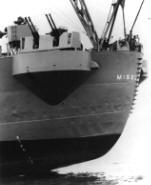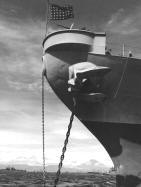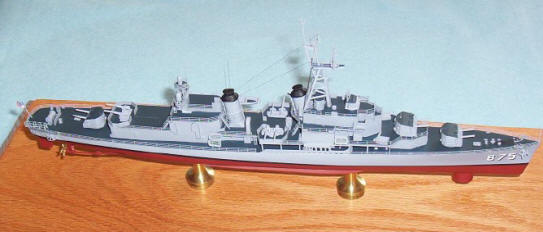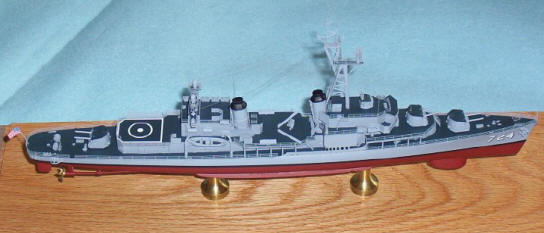By A. D. Jensen
The GEARING-class (DD-710) destroyers were basically a stretch-version of the
ALLEN M. SUMNER class (DD-692) featured in our July-August-September 1988
newsletter.
They were barely distinguishable from their predecessors, unless a
GEARING and a SUMNER were side by side. Then, the greater length of the GEARING’s hull amidships was obvious.
The navy acknowledged the similarity, referring to the two classes in official
navy publications as SUMNER Class (Short Hull) and GEARING Class (Long Hull).
As originally designed the GEARINGs
had the following characteristics:
Measurements
Length overall: 390’-6"
Extreme beam: 41’-6"
Displacement: 2,425 tons Standard
Armament
Three, twin 5-inch/38 caliber gun mounts
Two, quadruple 40-mm and two, twin 40-mm gun mounts
Ten, single 20-mm gun mounts
Two, quintuple 21-inch torpedo tubes
Two depth charge release tracks (for 600 pound Charges)
Six, single K-Gun depth charge throwers (for 300 pound Charges)
Machinery
Four boilers
Two sets geared turbines
Two shafts/screws
Shaft horsepower: 60,000
Speed: 35 knots
Manning
Officers: 11
Enlisted: 325
After World II, new Soviet submarines, engineered and built using the
technology of the German Type-XXI U-boats, began to appear. This emerging Soviet
submarine threat roused considerable concern among the free-world navies. Using
experience gained by confrontations with the German "wolf packs" during the
Battle of the Atlantic, the U.S. Navy developed new antisubmarine warfare (ASW)
weapons and sonars. The GEARINGs offered an ideal platform for testing the new
systems. To that end, a number of them were converted specifically for that
purpose and became escort destroyers (DDE). They mounted trainable hedgehog and
Weapon Able projectors and a new omnidirectional sonar.
The operational experience gained from these special ASW-type destroyers was
valuable in the navy’s development of two major antisubmarine warfare systems
during the 1950s: the Antisubmarine Rocket (ASROC) and the Drone Antisubmarine
Helicopter (DASH) standoff weapons. Although the GEARING hulls provided an
adequate platform, they were aging and needed major overhaul and reconstruction
to accommodate the new weapons systems. After careful analysis of the situation,
the Secretary of the Navy initiated the Fleet Rehabilitation and Modernization
(FRAM) program. Besides extensively refurbishing their hulls and machinery, the
ships received a completely new superstructure. Following their modernization,
the GEARINGs presented a more boxlike, yet modern, silhouette.
The FRAM program consisted of two levels of
modernization. Whereas most of the GEARINGs received the more extensive FRAM I
reconstruction, a few underwent the somewhat less extensive FRAM II program. The
latter, with a few exceptions, were those ships that had been converted from
DDEs and DDRs. The FRAM I GEARINGS received both ASROC and DASH systems. To
compensate for the weight of the ASROC system, they lost one of their twin
5-inch gun mounts. FRAM II, on the other hand, was developed primarily for the
SUMNERs because they did not have enough hull length amidships to accommodate
the ASROC system. They kept all three of their 5-inch gun mounts.
The GEARINGs were the last World War II destroyers
built by the U.S. Navy, and many of them served well into the 1970s. Stricken
from U.S. Navy lists, a number of them continued their service in foreign
navies. They survived because they were large enough to adapt to the changing
requirements of new weaponry and tactics. To say they were superb ships is
perhaps an understatement.




